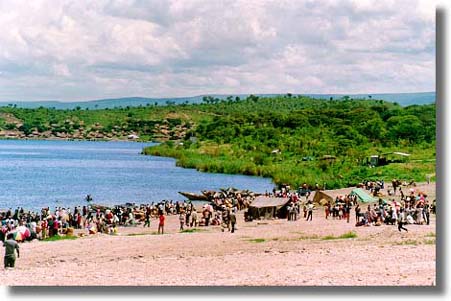
Integrated Rural Family Aquaculture Programme in Zambia
Integrated Rural Family Aquaculture Programme in Zambia
By Daniel Irvine, Peace Corps/Zambia
This initiative is the result of collaboration between the Zambian Department of Fisheries (DOF) and the U.S. Peace Corps. The initiative’s goals include improved yield of farmers' ponds (to 3000 kg/hectare/year), improved fish farmer per capita income (increase of 170%), fish farmer independence, retraining of fish culture extension agents, and development of an appropriate national plan for aquaculture. The program also encompasses farm level fingerling production, identification of efficient local inputs and marketing. To address these goals, the program is teaching farmers appropriate aquacultural methodologies. The program design includes a curriculum of fish farming techniques ranging from site selection and pond construction to pond management and marketing. Initially, attainment of objectives depends on an intensive extension effort with regular and frequent visits to farmers, done by teams of DOF agents and Peace Corps Volunteers. The curriculum being presented to farmers represents all the information necessary to become independent fish producers. The program encourages participants to maintain a standard level of quality in their practices. These standards include the following items:
# Site Selection and Pond Selection
The farmer has a year round, undisputed water supply for proposed ponds with complete legal and traditional rights to the proposed site. The site is located no more than 20 minutes walk from the home and the site has adequate soil quality for pond construction and water retention. The site is spacious enough for a multiple pond system and the slope of the site is sufficient for a gravity flow fill/drain system. Ponds are derivation, independently filling and draining. Dikes are constructed with a one meter minimum top width, 3:1 width to height ratio on interior slopes, 2:1 ratio on exterior slopes and a 30 centimeter minimum “freeboard” between water level and dike top. Compost fences should cover 10% of the pond surface area, with one fence per are of surface area; fence top does not exceed water level. Horizontally growing grass should be planted on all dike tops and exterior slopes.
# Stocking
Stocking is done only once the pond has achieved a phytoplankton bloom. Monoculture of Oreochromis andersonii is the standard, while monoculture of Oreochromis niloticus is being studied for use in 1998. Stocking rate is one 5 centimeter fingerling per square meter of surface area adding 10% for mortality.
# Management
Compost fences are filled once a week, compost is turned daily. Fish are fed supplementary feeds two times a day. The pond site is continuously maintained, grass/weeds cut, etc. Water level is kept stable with no flow through. Farmers maintain their own records of stocking, management and harvest results. Harvests are total. Pond is completely dried before re-filling.
While many systems exist for fish farming, and each farmer eventually designs a system appropriate for his/her needs, there are minimum requirements to achieve good production. Furthermore, a minimal level of productivity is essential in maintaining interest and growth in the activity. Also, it has been found by instituting standards in a program farmers feel they have a tangible guideline to follow. This is a guideline that once put into practice can not be forgotten when the program moves on. Furthermore, it creates a basis on which farmers can evaluate their own success, and for DOF to evaluate their progress as well.
At the center of the extension approach lies the formation of “model farmers”. Model farmers represent not only the program beneficiaries, but are the primary counterparts as well. They receive the major investment from the program in terms of transfer of knowledge and techniques. These are farmers who have the capacity to understand and apply productive fish farming techniques, who adopt these techniques, achieving desired yields on a regular basis, and who become completely independent of extension support. Their work serves as a model to their community as to how to be successful in fish farming. It is essential they go beyond the model and share their knowledge with others. For continuity, the program will encourage work groups and farmer associations.
Results of initial efforts have been encouraging. In the three pilot areas 23 farmers have begun to build ponds according to program standards, while another 23 farmers are adopting the program’s management techniques. Agents in the field are averaging 11 visits to each farmer per quarter. General orientation meetings have been held at the village level with over 300 farmers. The program organised a three week technical training for eight DOF extension agents. UNDP Zambia has been impressed with the program's initial results and included it in it’s funding component for the next five years.
While the program has targeted five provinces in Zambia which have the highest potential for success, it is hoped the model and the lessons learned will eventually encompass the entire country.
For more information concerning the program, please contact: Daniel Irvine, Fisheries Project Assistant, Peace Corps/Zambia, Box 50707, Lusaka, Zambia.
Fax: 260685, e-mail: pczambia@zamnet.zm